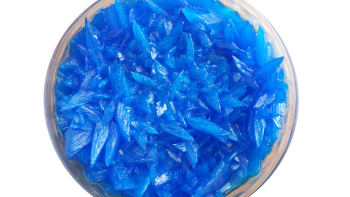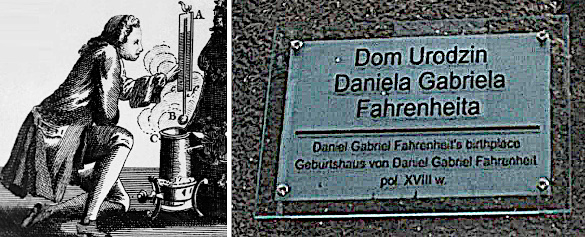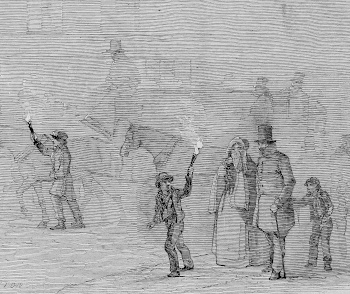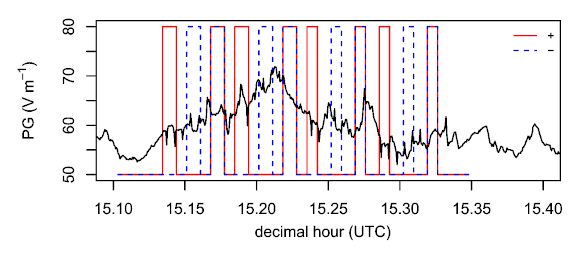Cloud Seeding
January 16, 2023
One
experiment that I remember from
high school chemistry was
crystallization of
copper(II) sulfate, CuSO4 from an
aqueous solution. In this simple experiment, each
student created a
saturated solution of CuSO
4, poured some into a
watch glass, and then placed these on a
radiator in an adjacent room. My high school was heated by the same type of
cast iron radiator used as a
plot point in some
comedy films and
animated cartoons of the early
20th century.
Beautiful blue
crystals were found in place of the blue solution the next day.

Copper(II) sulfate pentahydrate, CuSO4·5H2O, crystals.
Copper(II) sulfate forms hydrated crystals of the form, CuSO4·nH2O, where n can range from 1 to 7. However, the pentahydrate (n = 5) is the most common, and its crystals have the bright blue color shown. One ancient name for this crystal is blue vitriol, derived from oil of vitriol, the ancient name for sulfuric acid.
(Wikimedia Commons image by Crystal Titan. Click for larger image.)
As I wrote in an
earlier article (Supercooled Water, September 24, 2018), some things are
learned, not from
textbooks, but from an
oral tradition passed from
professor to student. That's how I learned the
old chemist's tale that
bearded chemists had more luck
crystallizing products from
solutions. The supposed reason was that
crystals need to
nucleate, and the
dust from a chemist's beard provides such nuclei when it falls into solution.
Clouds at low
altitudes are composed of
water droplets that are so small that they are
buoyant in
air. Higher altitude
cirrus clouds are composed of small
ice crystals that are also buoyant in air. In some cases, a cloud will contain
supercooled water, and this water can be nucleated into ice particles that are heavy enough to fall and become
rain as they warm in the lower atmosphere. Supercooled water is
liquid water below its
freezing point, and it stays liquid since the ice hasn't nucleated. Supercooling was first identified by
Daniel Fahrenheit (1686-1736), for whom the
Fahrenheit temperature scale is named, in 1724.[1]

Daniel Fahrenheit (1686-1736). At the right is a commemorative plaque at the birthplace of Daniel Fahrenheit in Gdansk, Poland. Although born in Poland, Fahrenheit spent most of his life in the Dutch Republic. (Left image of Fahrenheit via Wikimedia Commons. Right image, an enhanced portion of a Wikimedia Commons image by Starscream. Click for larger image.)
Magazines of the
1950s published many articles about
cloud seeding, the
idea that
injection of
material into
clouds can make
rain. Unlike other
dubious methods in the
history of
rainmaking, cloud seeding has some
science behind it, the same nucleation process exploited by our bearded chemists. The unlikely
pioneer of cloud seeding was
General Electric, which found that
dry ice and crystals of
silver iodide would
efficiently nucleate ice in a supercooled water atmosphere.[2] In the
United Kingdom,
Project Cumulus was a series of cloud seeding experiments between 1949 and 1952.
A decade later,
Project Skywater was
funded as a
weather modification program in the
US Bureau of Reclamation with the goal of demonstrating that cloud seeding was
environmentally and
economically practical.[3] The initial project funding was $100,000, which is about a million
dollars in
today's money.[3] A few years after the inception of Project Skywater, the
US National Academy of Sciences released a report that was critical of the idea that weather could be changed so easily.[3] Project Skywater produced no
data that confirmed the
feasibility of beneficial
rainmaking.[3]
The 1970 Colorado River Basin Pilot Project was a large
winter cloud-seeding program in the
Colorado River basin.[3] This program seeded about a third of the
winter storms during its operation and concluded that more than half of those seedings resulted in higher
precipitation.[3] In 2015, the
Wyoming Weather Modification Pilot Project completed a six year study on the effectiveness of cloud seeding for increased
snowfall. The study found that seeding increased snowfall by 5-15% in the
mountains of
Wyoming. This is a small effect, but it appeared that all of the more than a hundred trials increased snowfall by a
measurable amount.
Other
countries appear to have had success in weather modification. The
China Meteorological Administration uses
anti-aircraft cannons to inject silver iodide into the atmosphere with the claim that this action created 250 billion
metric tons of rain over a seven-year period.[3] One problem in using silver iodide as the seeding material is its small
toxicity, and there's the possibility that long term cloud seeding will cause
silver to be accumulated in the atmosphere,
groundwater, and
plants.[3]
A recent
open access paper in
Geophysical Research Letters by
scientists at the
University of Reading (Berkshire, UK) and the
University of Bath (Bath, UK) reports on a method of cloud seeding that doesn't rely on a
chemical agent.[4] This research was specifically directed to modification of
fog clouds, and the agent for modification was
electric charge delivered by an
unmanned aerial vehicle (UAV).[4-6] The study authors were perhaps inspired by the notorious
English fogs (see image).

This engraving of a London fog by Henry Linton (1815–1899), published in The Illustrated London News of January 2, 1847, shows people carrying flaming torches to lead the way for others.
The burning of soft coal containing sulfur within the city during the 19th century created a thick, poisonous fog. This fog, called a pea soup fog because of its yellow-green color, was likely responsible for many deaths in the city.
(Portion of A Wikimedia Commons image, Wellcome Trust photo no. L0032640. Click for larger image.)
Prior research established that electrically charged water droplets are more likely to
adhere to each other when they
collide, so the droplet size increases.[4] Too much charging will result in
electrical forces that exceed the droplet
surface tension, at which point the large droplets will
fragment.[4] Such droplet charging in clouds has been realized by injecting
corona discharge ions upwards from the
ground.[4] Fog droplets are typically about 1-10
micrometer in
diameter, smaller than cloud droplets, so electrical effects are
proportionally greater, and the UAV
propulsion batteries are available to provide the charging.[4] An
unpopulated valley with frequent fog in
Somerset, England, at 51.09788°N, 2.486905°W, near
Castle Cary, was the area used for this study.[4]
Giles Harrison,
lead author of the study and a professor of
atmospheric physics in the
Department of Meteorology at the University of Reading, is
quoted in
The Guardian as saying,
“Electric charge can slow evaporation, or even - and this is always amazing to me - cause drops to explode because the electric force on them exceeds the surface tension holding them together."[5]
In the experiments, the UAV flew in a
circular,
horizontal pattern above the measurement site, and the electric field and droplet characteristics were
recorded.[5-6] The
positive and
negative charge emitters of the UAV were alternately switched on, and an onboard downwards-looking
optical sensor monitored ground
visibility.[6] The optical sensor showed that the injection of ions of both
polarities caused brief changes in the fog
reflectance, and this was indicative of changes in the droplet
size distribution.[4,6] The maximum change in fog reflectivity from charging was about 2%, and this occurred with about half a minute lag.[4]

Time series of surface potential gradient (PG). Switching of the positive (red) and negative (blue) charge emitters are marked. Figure 2(b) of ref. 4, licensed under the terms of the Creative Commons Attribution License. (Click for larger image.)
These experiments demonstrated the
feasibility of using charge-injecting UAVs to modify fog; and, potentially, seeding clouds without chemicals.[5-6] Despite its limited
efficacy, cloud seeding is still a big thing. The
US National Oceanic and Atmospheric Administration has identified more than 50 cloud seeding programs started since 2000.[6] The
US state of
Utah spends about $700,000 annually on cloud-seeding projects, and cloud seeding has been proposed a a way to save its
Great Salt Lake.[6]
References:
- Experimental explanation of supercooling : why water does not freeze in the clouds, European Synchrotron Radiation Facility Website, April 21, 2010.
- Tomas Kellner, "Cool Science: How Kurt Vonnegut's Brother Tried To Break Up Hurricanes," General Electric Website, July 8, 2020.
- Jedediah S. Rogers, "Project Skywater," Historic Reclamation Projects, Bureau of Reclamation, 2009 (Reformatted, reedited, and reprinted by Andrew H. Gahan, July, 2013. PDF file.)
- R. Giles Harrison, Keri A. Nicoll, Graeme J. Marlton, Douglas J. Tilley, and Pejman Iravani, "Ionic Charge Emission Into Fog From a Remotely Piloted Aircraft," Geophysical Research Letters, vol. 49, no. 19 (October 16, 2022), Article no. e2022GL099827, https://doi.org/10.1029/2022GL099827. This is an open access publication with a PDF file available at the same URL.
- Kate Ravilious, "Scientists zap clouds with electricity to make them rain," The Guardian, November 3, 2022.
- Baba Tamim, "Scientists electrically charge ‘constipated’ clouds to make them rain," Interesting Engineering, November 4, 2022.
Linked Keywords:
Experiment; high school; chemistry; crystallization; copper(II) sulfate, CuSO4; aqueous solution; student; solubility; saturated solution; watch glass; radiator (heating); cast iron; plot point; comedy film; animated cartoon; 20th century; beauty; beautiful; crystal; Copper(II) sulfate pentahydrate, CuSO4·5H2O; hydrate; hydrated; ancient history; sulfuric acid; oil of vitriol; Wikimedia Commons; education; textbook; oral tradition; professor; old wives' tale; old chemist's tale; beard; bearded; chemist; crystallizing; product (chemistry); nucleation; nucleate; dust; cloud; altitude; water; drop (liquid); droplet; buoyancy; buoyant; atmosphere of Earth; air; cirrus cloud; ice; supercooling; supercooled; rain; liquid water; melting point; freezing point; Daniel Fahrenheit (1686-1736); Fahrenheit temperature scale; commemorative plaque; birthplace; Gdansk, Poland; Dutch Republic; Starscream; magazine; 1950s; publishing; publish; cloud seeding; idea; inject; injection; material; rain; dubious; history; rainmaking; science; innovation; pioneer; General Electric; dry ice; silver iodide; efficiency; efficiently; United Kingdom; Project Cumulus; Project Skywater; funding of science; funded; weather modification; United States Bureau of Reclamation; environment (biophysical); environmentally; economics; economically<; United States dollar; inflation; today's money; US National Academy of Sciences; data; feasibility study; winter; Colorado River basin; winter storm; precipitation (meteorology); Wyoming Weather Modification Pilot Project; snow; snowfall; mountain; Wyoming; measurement; measurable; country; countries; China Meteorological Administration; anti-aircraft cannon; metric ton; toxicity; silver; groundwater; plant; open access paper; Geophysical Research Letters; University of Reading (Berkshire, UK); University of Bath (Bath, UK); chemical substance; chemical agent; fog; electric charge; unmanned aerial vehicle (UAV); England; English; engraving; London; fog; Henry Linton (1815–1899); The Illustrated London News; flaming torch; combustion; burning; bituminous coal; soft coal; sulfur; 19th century; toxic; poisonous; pea soup fog; death; Wellcome Trust; adhesion; adhere; collision; collide; Coulomb's law; electrical force; surface tension; explosion; fragment; corona discharge; ion; lithosphere; ground; micrometer; diameter; proportionality (mathematics); proportionally; propulsion; battery (electricity); population; unpopulated; valley; Somerset, England; Castle Cary; Giles Harrison; academic authorship; lead author; atmospheric physics; Department of Meteorology at the University of Reading; quotation; quoted; The Guardian; evaporation; explode; circle; circular; horizontal; data acquisition; recorded; electrical polarity; positive; negative<; optics; optical; sensor; transparency and translucency; visibility; reflectivity; reflectance; particle-size distribution; time series; surface; potential gradient; Creative Commons Attribution License; efficacy; US National Oceanic and Atmospheric Administration; US state; Utah; Great Salt Lake.